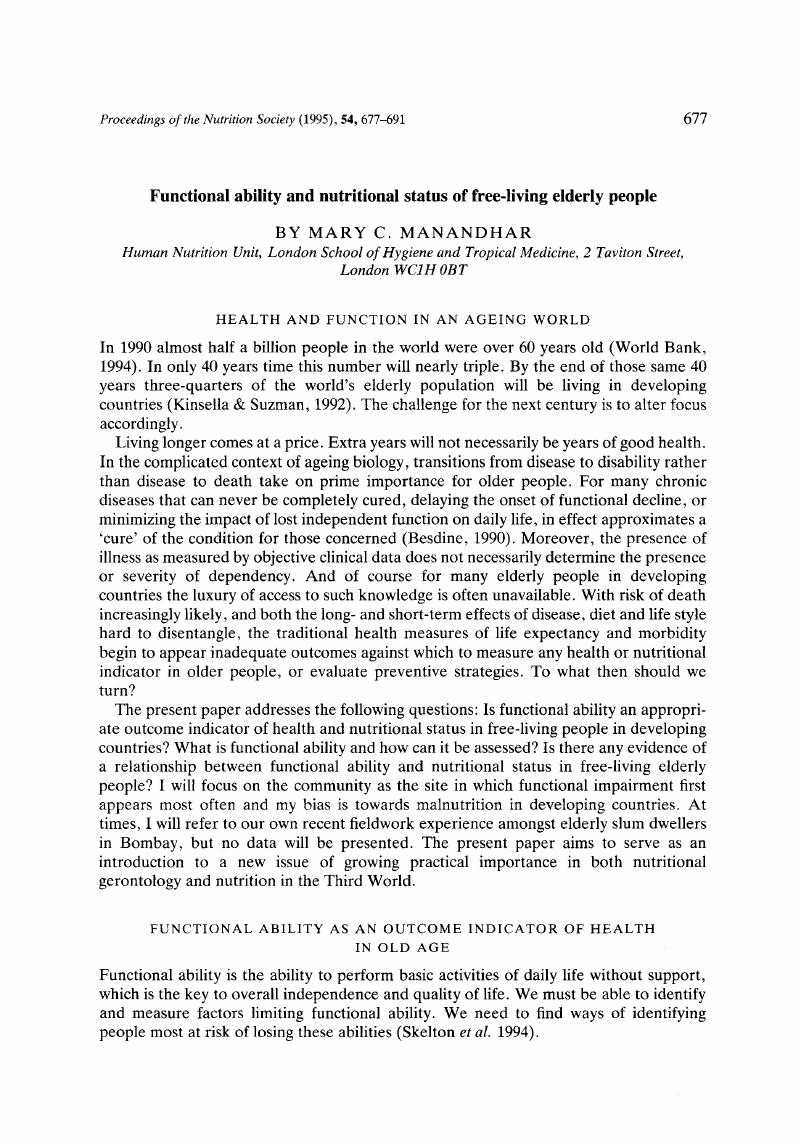Crossref Citations
This article has been cited by the following publications. This list is generated based on data provided by Crossref.
Barberger-Gateau, Pascale
and
Fabrigoule, Colette
1997.
Disability and cognitive impairment in the elderly.
Disability and Rehabilitation,
Vol. 19,
Issue. 5,
p.
175.
Pieterse, Simone
Manandhar, Mary
and
Ismail, Suraiya
1998.
The nutritional status of older Rwandan refugees.
Public Health Nutrition,
Vol. 1,
Issue. 4,
p.
259.
Hare, Caroline
Kirk, David
and
Lang, Tim
1999.
Identifying the expectations of older food consumers.
Journal of Marketing Practice: Applied Marketing Science,
Vol. 5,
Issue. 6/7/8,
p.
213.
Zohoori, Namvar
2001.
Nutrition and Healthy Functioning in the Developing World.
The Journal of Nutrition,
Vol. 131,
Issue. 9,
p.
2429S.
Pieterse, S
Manandhar, M
and
Ismail, S
2002.
The association between nutritional status and handgrip strength in older Rwandan refugees.
European Journal of Clinical Nutrition,
Vol. 56,
Issue. 10,
p.
933.
Sharkey, Joseph R
Giuliani, Carol
Haines, Pamela S
Branch, Laurence G
Busby-Whitehead, Jan
and
Zohoori, Namvar
2003.
Summary measure of dietary musculoskeletal nutrient (calcium, vitamin D, magnesium, and phosphorus) intakes is associated with lower-extremity physical performance in homebound elderly men and women.
The American Journal of Clinical Nutrition,
Vol. 77,
Issue. 4,
p.
847.
Bedard, Michel
Squire, Larry
Minthorn-Biggs, Mary-Beth
Molloy, D. William
Dubois, Sacha
O'donnell, Martin
and
Lever, Judith A.
2003.
Validity of Self-Reports in Dementia Research.
Clinical Gerontologist,
Vol. 26,
Issue. 3-4,
p.
155.
Bear-Lehman, Jane
Miller, Patricia A.
Adler, Marlo
Buonocore, Jennifer Murray
Coles, Nancy
Kneafsey, Barbara Sweeney
Katz-Sillman, Faygie
and
Sherman-Amsel, Hindy
2003.
An Exploration of Hand Strength and Sensation in Community Elders.
Topics in Geriatric Rehabilitation,
Vol. 19,
Issue. 2,
p.
127.
Woodliffe, Lucy
2004.
Rethinking consumer disadvantage: the importance of qualitative research.
International Journal of Retail & Distribution Management,
Vol. 32,
Issue. 11,
p.
523.
Larrieu, S
Pérès, K
Letenneur, L
Berr, C
Dartigues, J F
Ritchie, K
Février, B
Alpérovitch, A
and
Barberger-Gateau, P
2004.
Relationship between body mass index and different domains of disability in older persons: the 3C study.
International Journal of Obesity,
Vol. 28,
Issue. 12,
p.
1555.
Sharkey, Joseph R.
and
Branch, Laurence G.
2004.
Gender Differences in Physical Performance, Body Composition, and Dietary Intake in Homebound Elders.
Journal of Women & Aging,
Vol. 16,
Issue. 3-4,
p.
71.
Kikafunda, Joyce K.
and
Lukwago, Fred B.
2005.
Nutritional status and functional ability of the elderly aged 60 to 90 years in the Mpigi district of central Uganda.
Nutrition,
Vol. 21,
Issue. 1,
p.
59.
Keller, Heather H.
2005.
Reliance on Others for Food-Related Activities of Daily Living.
Journal of Nutrition For the Elderly,
Vol. 25,
Issue. 1,
p.
43.
Meydani, Ahou
Ahmed, Tanvir
and
Meydani, Simin Nikbin
2005.
Aging, Nutritional Status, and Infection in the Developing World.
Nutrition Reviews,
Vol. 63,
Issue. 7,
p.
233.
Wouters-Wesseling, W.
Wagenaar, L. W.
Rozendaal, M.
Deijen, J. B.
de Groot, L. C.
Bindels, J. G.
and
van Staveren, W. A.
2005.
Effect of an Enriched Drink on Cognitive Function in Frail Elderly Persons.
The Journals of Gerontology Series A: Biological Sciences and Medical Sciences,
Vol. 60,
Issue. 2,
p.
265.
Hewitt, Gillian
Draper, Alizon
Ismail, Suraiya
and
Patterson, Sybil
2007.
Improving food provision in a Guyanese home for the elderly: a participatory approach.
Public Health Nutrition,
Vol. 10,
Issue. 6,
p.
552.
Ferdous, Tamanna
Cederholm, Tommy
Razzaque, Abdur
Wahlin, Åke
and
Nahar Kabir, Zarina
2009.
Nutritional status and self-reported and performance-based evaluation of physical function of elderly persons in rural Bangladesh.
Scandinavian Journal of Public Health,
Vol. 37,
Issue. 5,
p.
518.
Han, Yanhong
Li, Sijian
and
Zheng, Yanling
2009.
Predictors of nutritional status among community-dwelling older adults in Wuhan, China.
Public Health Nutrition,
Vol. 12,
Issue. 8,
p.
1189.
Lachman, Margie E.
Agrigoroaei, Stefan
and
Baune, Bernhard T.
2010.
Promoting Functional Health in Midlife and Old Age: Long-Term Protective Effects of Control Beliefs, Social Support, and Physical Exercise.
PLoS ONE,
Vol. 5,
Issue. 10,
p.
e13297.
Renko, Sanda
Ozimek, Irena
and
Żakowska‐Biemans, Sylwia
2011.
Determinants of Polish consumers' food choices and their implication for the national food industry.
British Food Journal,
Vol. 113,
Issue. 1,
p.
138.





